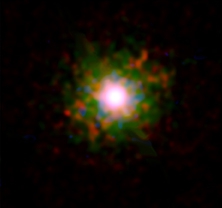Top Qs
Timeline
Chat
Perspective
Circinus X-1
Binary star in the constellation Circinus From Wikipedia, the free encyclopedia
Remove ads
Circinus X-1 is an X-ray binary star system that includes a neutron star. Observation of Circinus X-1 in July 2007 revealed the presence of X-ray jets normally found in black hole systems; it is the first of the sort[clarification needed] to be discovered that displays this similarity to black holes. Circinus X-1 may be among the youngest X-ray binaries observed.
Remove ads
Location, distance
On June 14, 1969, an Aerobee 150 rocket, launched from Natal, Rio Grande do Norte, Brazil, obtained X-ray data during a scan of the Norma-Lupus-Circinus region that detected a well-isolated source at ℓ = 321.4±0.9° b = -0.5±2° (galactic), RA 15h 14m Dec −57° 49′ within the constellation Circinus and referred to as Circinus XR-1 (Cir XR-1).[6] The distance of Circinus X-1 was not well established, with a low estimate of 13,400 light years[7] and high estimate of 26,000 light years.[8]
On June 23, 2015, an article published on NASA's Chandra X-Ray Observatory's website, revealed that an international team of astronomers has succeeded in determining its distance from Earth with more precision - via a method of triangulation of X-ray light emitted by the star, echoing through stellar clouds and interstellar dust - as being about 30,700 light-years.[9]
Remove ads
X-ray source and age related to supernova remnant

A 16.6 day X-ray period was found by Kaluzienski et al.[11] The X-ray source is assumed to be a neutron star as part of a low-mass X-ray binary (LMXB), type-I X-ray burster.[12] The X-ray and radio nebulae surrounding Circinus X-1 have properties consistent with a young supernova remnant. This rare case of an X-ray binary apparently associated with a supernova remnant suggests the binary is very young on cosmic time scales, possibly less than 4600 years old.[13] An association of Circinus X-1 with a different nearby supernova remnant, G321.9-0.3, has been ruled out.[12]

Remove ads
Other spectral regions
The binary nature of Cir X-1 has been established.[14] The binary's radio component and a possible visual counterpart were identified by Whelan et al.[15] Its infrared counterpart was located and found to flare with a 16.6-day period by Glass.[16] A (heavily reddened) precise optical counterpart (now known as BR Cir) was identified by Moneti.[17]
References
External links
Wikiwand - on
Seamless Wikipedia browsing. On steroids.
Remove ads

